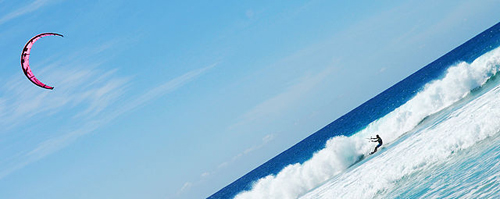Activities

Kitesurfing or Kiteboarding is an adventure surface water sport that has been described as combining wakeboarding, windsurfing, surfing, paragliding, and gymnastics into one extreme sport. Kitesurfing harnesses the power of the wind to propel a rider across the water on a small surfboard or a kiteboard (similar to a wakeboard). The terms kiteboarding and kitesurfing are interchangeable. There are a number of different styles of kiteboarding, including freestyle, freeride, downwinders, speed, course racing, wakestyle, jumping and wave-riding which is focused on kitesurfing big waves using a directional board similar to a surfboard.
A kitesurfer or kiteboarder uses a board with or without foot-straps or bindings, combined with the power of a large controllable kite to propel the rider and the board across the water. In 2006, the number of kitesurfers has been estimated at around 150,000 to 210,000, with 114,465 inflatable kites sold that same year.
Although kitesurfing is an extreme sport, its safety record is improving due to advances in hybrid and bow kite designs and the ability to control the power that they provide, effective safety release systems, wider availability of kiteboarding schools, international and regional oversight provided by kitesurfing organizations and improving teaching standards as the sport matures. There are still a number of deaths every year and a much larger number of serious injuries and accidents.
History
In the 1800s George Pocock used kites of increased size to propel carts on land and ships on the water, using a four-line control system - the same system in common use today. Both carts and boats were able to turn and sail upwind. The kites could be flown for sustained periods. The intention was to establish kitepower as an alternative to horsepower, partly to avoid the hated "horse tax" that was levied at that time. In 1903, aviation pioneer Samuel Cody developed "man-lifting kites" and succeeded in crossing the English channel in a small collapsible canvas boat powered by a kite.
In the late 1970s the development of Kevlar then Spectra flying lines and more controllable kites with improved efficiency contributed to practical kite traction. In 1978, Ian Day's "FlexiFoil" kite-powered Tornado catamaran exceeded 40 km/h.
Through the 1980s there were occasionally successful attempts to combine kites with canoes, ice skates, snow skis,water skis and roller skates.
Throughout the 1970s and early 1980s Dieter Strasilla from Germany developed parachute-skiing and later perfected a kiteskiing system using self made paragliders and a ball-socket swivel allowing the pilot to kitesail upwind and uphill but also to take off into the air at will. Strasilla and his friend Andrea Kuhn/Switzerland used this invention also in combination with surfboards and Skurfs, grasskies and selfmade buggies. One of his patents describes in 1979 the first use of an inflatable kite design for kitesurfing.
Two brothers, Bruno Legaignoux and Dominique Legaignoux, from the Atlantic coast of France, developed kites for kitesurfing in the late 1970s and early 1980s and patented an inflatable kite design in November 1984, a design that has been used by companies to develop their own products.
In 1990, practical kite buggying was pioneered by Peter Lynn at Argyle Park in Ashburton, New Zealand. Lynn coupled a three-wheeled buggy with a forerunner of the modern parafoil kite. Kite buggying proved to be very popular worldwide, with over 14,000 buggies sold up to 1999.
The development of modern day kitesurfing by the Roeselers in the USA and the Legaignoux in France carried on in parallel to buggying. Bill Roeseler, a Boeing aerodynamicist, and his son Cory Roeseler patented the "KiteSki" system which consisted of water skis powered by a two line delta style kite controlled via a bar mounted combined winch/brake. The KiteSki was commercially available in 1994. The kite had a rudimentary water launch capability and could go upwind. In 1995, Cory Roeseler visited Peter Lynn at New Zealand's Lake Clearwater in the Ashburton Alpine Lakes area, demonstrating speed, balance and upwind angle on his 'ski'. In the late 1990s, Cory's ski evolved to a single board similar to a surfboard.
In 1996 Laird Hamilton and Manu Bertin were instrumental in demonstrating and popularising kitesurfing off the Hawaiian coast of Maui.
In 1997 the Legaignoux brothers developed and sold the breakthrough "Wipika" kite design which had a structure of preformed inflatable tubes and a simple bridle system to the wingtips, both of which greatly assisted water re-launch. Bruno Legaignoux has continued to improve kite designs, including developing the bow kite design, which has been licensed to many kite manufacturers.
In 1997, specialist kiteboards were developed by Raphaël Salles and Laurent Ness. By 1998 kitesurfing had become a mainstream sport, and several schools were teaching kitesurfing. The first competition was held on Maui in September 1998 and won by Flash Austin.
By 1999 single direction boards derived from windsurfing and surfing designs became the dominant form of kiteboard. From 2001 onwards, twin-tip bi-directional boards became more popular for most flat water riders, with directional boards still in use for surf conditions.
Governance
There is currently no single internationally recognised governing body for kitesurfing. The International Kiteboarding Organization's (IKO) mission is to develop and promote the safe practice of kiteboarding, and provides certification of kitesurfing examiners and instructors. The International Kiteboarding Association (IKA) is an International Class Association of the International Sailing Federation (ISAF). Its responsibility, amongst others, is to manage the global administration of the sport and combining world events into one united ranking.
There are also national and regional kitesurfing associations in many countries.
Description from Wikipedia under the Creative Commons Attribution-ShareAlike 3.0 Unported License. Photo from
Events (0)
Kiteboarding

Kitesurfing or Kiteboarding is an adventure surface water sport that has been described as combining wakeboarding, windsurfing, surfing, paragliding, and gymnastics into one extreme sport. Kitesurfing harnesses the power of the wind to propel a rider across the water on a small surfboard or a kiteboard (similar to a wakeboard). The terms kiteboarding and kitesurfing are interchangeable. There are a number of different styles of kiteboarding, including freestyle, freeride, downwinders, speed, course racing, wakestyle, jumping and wave-riding which is focused on kitesurfing big waves using a directional board similar to a surfboard.
A kitesurfer or kiteboarder uses a board with or without foot-straps or bindings, combined with the power of a large controllable kite to propel the rider and the board across the water. In 2006, the number of kitesurfers has been estimated at around 150,000 to 210,000, with 114,465 inflatable kites sold that same year.
Although kitesurfing is an extreme sport, its safety record is improving due to advances in hybrid and bow kite designs and the ability to control the power that they provide, effective safety release systems, wider availability of kiteboarding schools, international and regional oversight provided by kitesurfing organizations and improving teaching standards as the sport matures. There are still a number of deaths every year and a much larger number of serious injuries and accidents.
History
In the 1800s George Pocock used kites of increased size to propel carts on land and ships on the water, using a four-line control system - the same system in common use today. Both carts and boats were able to turn and sail upwind. The kites could be flown for sustained periods. The intention was to establish kitepower as an alternative to horsepower, partly to avoid the hated "horse tax" that was levied at that time. In 1903, aviation pioneer Samuel Cody developed "man-lifting kites" and succeeded in crossing the English channel in a small collapsible canvas boat powered by a kite.
In the late 1970s the development of Kevlar then Spectra flying lines and more controllable kites with improved efficiency contributed to practical kite traction. In 1978, Ian Day's "FlexiFoil" kite-powered Tornado catamaran exceeded 40 km/h.
Through the 1980s there were occasionally successful attempts to combine kites with canoes, ice skates, snow skis,water skis and roller skates.
Throughout the 1970s and early 1980s Dieter Strasilla from Germany developed parachute-skiing and later perfected a kiteskiing system using self made paragliders and a ball-socket swivel allowing the pilot to kitesail upwind and uphill but also to take off into the air at will. Strasilla and his friend Andrea Kuhn/Switzerland used this invention also in combination with surfboards and Skurfs, grasskies and selfmade buggies. One of his patents describes in 1979 the first use of an inflatable kite design for kitesurfing.
Two brothers, Bruno Legaignoux and Dominique Legaignoux, from the Atlantic coast of France, developed kites for kitesurfing in the late 1970s and early 1980s and patented an inflatable kite design in November 1984, a design that has been used by companies to develop their own products.
In 1990, practical kite buggying was pioneered by Peter Lynn at Argyle Park in Ashburton, New Zealand. Lynn coupled a three-wheeled buggy with a forerunner of the modern parafoil kite. Kite buggying proved to be very popular worldwide, with over 14,000 buggies sold up to 1999.
The development of modern day kitesurfing by the Roeselers in the USA and the Legaignoux in France carried on in parallel to buggying. Bill Roeseler, a Boeing aerodynamicist, and his son Cory Roeseler patented the "KiteSki" system which consisted of water skis powered by a two line delta style kite controlled via a bar mounted combined winch/brake. The KiteSki was commercially available in 1994. The kite had a rudimentary water launch capability and could go upwind. In 1995, Cory Roeseler visited Peter Lynn at New Zealand's Lake Clearwater in the Ashburton Alpine Lakes area, demonstrating speed, balance and upwind angle on his 'ski'. In the late 1990s, Cory's ski evolved to a single board similar to a surfboard.
In 1996 Laird Hamilton and Manu Bertin were instrumental in demonstrating and popularising kitesurfing off the Hawaiian coast of Maui.
In 1997 the Legaignoux brothers developed and sold the breakthrough "Wipika" kite design which had a structure of preformed inflatable tubes and a simple bridle system to the wingtips, both of which greatly assisted water re-launch. Bruno Legaignoux has continued to improve kite designs, including developing the bow kite design, which has been licensed to many kite manufacturers.
In 1997, specialist kiteboards were developed by Raphaël Salles and Laurent Ness. By 1998 kitesurfing had become a mainstream sport, and several schools were teaching kitesurfing. The first competition was held on Maui in September 1998 and won by Flash Austin.
By 1999 single direction boards derived from windsurfing and surfing designs became the dominant form of kiteboard. From 2001 onwards, twin-tip bi-directional boards became more popular for most flat water riders, with directional boards still in use for surf conditions.
Governance
There is currently no single internationally recognised governing body for kitesurfing. The International Kiteboarding Organization's (IKO) mission is to develop and promote the safe practice of kiteboarding, and provides certification of kitesurfing examiners and instructors. The International Kiteboarding Association (IKA) is an International Class Association of the International Sailing Federation (ISAF). Its responsibility, amongst others, is to manage the global administration of the sport and combining world events into one united ranking.
There are also national and regional kitesurfing associations in many countries.
Description from Wikipedia under the Creative Commons Attribution-ShareAlike 3.0 Unported License. Photo from
Your Friends With This Interest (0)
You need to be a member or be signed in for this.
Members With This Interest (0)
You need to be a member or be signed in for this.
Members With This Interest (0)
Groups (0)
Locations (8)
María Trinidad Sánchez - Amanera (Rio San Juan, María Trinidad Sánchez)
Puerto Plata - Dare2Fly Kiteboarding School - Cabarete (Cabarete, Puerto Plata)
- GoKite Cabarete (Cabarete, Puerto Plata)
- Kite Club Cabarete Kitesurfing School (Cabarete, Puerto Plata)
- Kitexcite Kiteboarding and Parasailing (Cabarete, Puerto Plata)
- Laurel Eastman Kiteboarding School (Cabarete, Puerto Plata)
Rivas - Surf Ranch Action Sports Resort (San Juan Del Sur, Rivas)
Western Cape - Table Mountain National Park (Cape Town, Western Cape)
Dominican Republic
Nicaragua
South Africa
Resources Powered by Barnes & Noble and Maps.com



